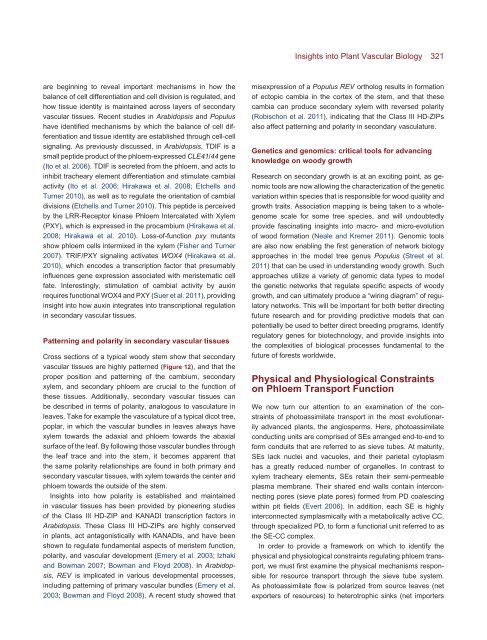The Plant Vascular System: Evolution, Development and FunctionsF
The Plant Vascular System: Evolution, Development and FunctionsF
The Plant Vascular System: Evolution, Development and FunctionsF
You also want an ePaper? Increase the reach of your titles
YUMPU automatically turns print PDFs into web optimized ePapers that Google loves.
are beginning to reveal important mechanisms in how the<br />
balance of cell differentiation <strong>and</strong> cell division is regulated, <strong>and</strong><br />
how tissue identity is maintained across layers of secondary<br />
vascular tissues. Recent studies in Arabidopsis <strong>and</strong> Populus<br />
have identified mechanisms by which the balance of cell differentiation<br />
<strong>and</strong> tissue identity are established through cell-cell<br />
signaling. As previously discussed, in Arabidopsis, TDIFisa<br />
small peptide product of the phloem-expressed CLE41/44 gene<br />
(Ito et al. 2006). TDIF is secreted from the phloem, <strong>and</strong> acts to<br />
inhibit tracheary element differentiation <strong>and</strong> stimulate cambial<br />
activity (Ito et al. 2006; Hirakawa et al. 2008; Etchells <strong>and</strong><br />
Turner 2010), as well as to regulate the orientation of cambial<br />
divisions (Etchells <strong>and</strong> Turner 2010). This peptide is perceived<br />
by the LRR-Receptor kinase Phloem Intercalated with Xylem<br />
(PXY), which is expressed in the procambium (Hirakawa et al.<br />
2008; Hirakawa et al. 2010). Loss-of-function pxy mutants<br />
show phloem cells intermixed in the xylem (Fisher <strong>and</strong> Turner<br />
2007). TRIF/PXY signaling activates WOX4 (Hirakawa et al.<br />
2010), which encodes a transcription factor that presumably<br />
influences gene expression associated with meristematic cell<br />
fate. Interestingly, stimulation of cambial activity by auxin<br />
requires functional WOX4 <strong>and</strong> PXY (Suer et al. 2011), providing<br />
insight into how auxin integrates into transcriptional regulation<br />
in secondary vascular tissues.<br />
Patterning <strong>and</strong> polarity in secondary vascular tissues<br />
Cross sections of a typical woody stem show that secondary<br />
vascular tissues are highly patterned (Figure 12), <strong>and</strong> that the<br />
proper position <strong>and</strong> patterning of the cambium, secondary<br />
xylem, <strong>and</strong> secondary phloem are crucial to the function of<br />
these tissues. Additionally, secondary vascular tissues can<br />
be described in terms of polarity, analogous to vasculature in<br />
leaves. Take for example the vasculature of a typical dicot tree,<br />
poplar, in which the vascular bundles in leaves always have<br />
xylem towards the adaxial <strong>and</strong> phloem towards the abaxial<br />
surface of the leaf. By following those vascular bundles through<br />
the leaf trace <strong>and</strong> into the stem, it becomes apparent that<br />
the same polarity relationships are found in both primary <strong>and</strong><br />
secondary vascular tissues, with xylem towards the center <strong>and</strong><br />
phloem towards the outside of the stem.<br />
Insights into how polarity is established <strong>and</strong> maintained<br />
in vascular tissues has been provided by pioneering studies<br />
of the Class III HD-ZIP <strong>and</strong> KANADI transcription factors in<br />
Arabidopsis. <strong>The</strong>se Class III HD-ZIPs are highly conserved<br />
in plants, act antagonistically with KANADIs, <strong>and</strong> have been<br />
shown to regulate fundamental aspects of meristem function,<br />
polarity, <strong>and</strong> vascular development (Emery et al. 2003; Izhaki<br />
<strong>and</strong> Bowman 2007; Bowman <strong>and</strong> Floyd 2008). In Arabidopsis,<br />
REV is implicated in various developmental processes,<br />
including patterning of primary vascular bundles (Emery et al.<br />
2003; Bowman <strong>and</strong> Floyd 2008). A recent study showed that<br />
Insights into <strong>Plant</strong> <strong>Vascular</strong> Biology 321<br />
misexpression of a Populus REV ortholog results in formation<br />
of ectopic cambia in the cortex of the stem, <strong>and</strong> that these<br />
cambia can produce secondary xylem with reversed polarity<br />
(Robischon et al. 2011), indicating that the Class III HD-ZIPs<br />
also affect patterning <strong>and</strong> polarity in secondary vasculature.<br />
Genetics <strong>and</strong> genomics: critical tools for advancing<br />
knowledge on woody growth<br />
Research on secondary growth is at an exciting point, as genomic<br />
tools are now allowing the characterization of the genetic<br />
variation within species that is responsible for wood quality <strong>and</strong><br />
growth traits. Association mapping is being taken to a wholegenome<br />
scale for some tree species, <strong>and</strong> will undoubtedly<br />
provide fascinating insights into macro- <strong>and</strong> micro-evolution<br />
of wood formation (Neale <strong>and</strong> Kremer 2011). Genomic tools<br />
are also now enabling the first generation of network biology<br />
approaches in the model tree genus Populus (Street et al.<br />
2011) that can be used in underst<strong>and</strong>ing woody growth. Such<br />
approaches utilize a variety of genomic data types to model<br />
the genetic networks that regulate specific aspects of woody<br />
growth, <strong>and</strong> can ultimately produce a “wiring diagram” of regulatory<br />
networks. This will be important for both better directing<br />
future research <strong>and</strong> for providing predictive models that can<br />
potentially be used to better direct breeding programs, identify<br />
regulatory genes for biotechnology, <strong>and</strong> provide insights into<br />
the complexities of biological processes fundamental to the<br />
future of forests worldwide.<br />
Physical <strong>and</strong> Physiological Constraints<br />
on Phloem Transport Function<br />
We now turn our attention to an examination of the constraints<br />
of photoassimilate transport in the most evolutionarily<br />
advanced plants, the angiosperms. Here, photoassimilate<br />
conducting units are comprised of SEs arranged end-to-end to<br />
form conduits that are referred to as sieve tubes. At maturity,<br />
SEs lack nuclei <strong>and</strong> vacuoles, <strong>and</strong> their parietal cytoplasm<br />
has a greatly reduced number of organelles. In contrast to<br />
xylem tracheary elements, SEs retain their semi-permeable<br />
plasma membrane. <strong>The</strong>ir shared end walls contain interconnecting<br />
pores (sieve plate pores) formed from PD coalescing<br />
within pit fields (Evert 2006). In addition, each SE is highly<br />
interconnected symplasmically with a metabolically active CC,<br />
through specialized PD, to form a functional unit referred to as<br />
the SE-CC complex.<br />
In order to provide a framework on which to identify the<br />
physical <strong>and</strong> physiological constraints regulating phloem transport,<br />
we must first examine the physical mechanisms responsible<br />
for resource transport through the sieve tube system.<br />
As photoassimilate flow is polarized from source leaves (net<br />
exporters of resources) to heterotrophic sinks (net importers
















